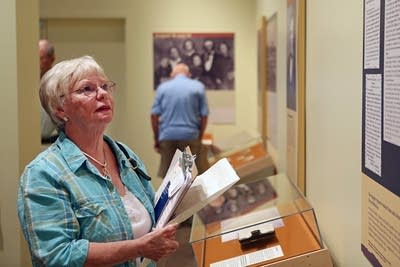Minnesota Sounds and Voices: White settlers' voices in US-Dakota War exhibit

Jan Klein, a descendant of white settlers killed in the US- Dakota War of 1862, wants to make sure her ancestors aren't forgotten, and she was one of 85 people who advised the Minnesota Historical Society on its exhibit about that war.
As part of his project to bring a range of perspectives on the exhibit and the history of that war to light, Minnesota Sounds and Voices reporter Dan Olson spent some time with Kline to hear what she had to say.
Klein's great, great grandfather, Charles Clasen, was killed by a Dakota fighter at the Birch Coulee battle, near what is now the town of Morton in southern Minnesota.
Walking through the historical society's exhibit in St. Paul, she can point to the man's name in the partial listing of settlers killed. She says her great, great grandfather's grave has not been located.
Create a More Connected Minnesota
MPR News is your trusted resource for the news you need. With your support, MPR News brings accessible, courageous journalism and authentic conversation to everyone - free of paywalls and barriers. Your gift makes a difference.
• Special Section: The US-Dakota War, 150 years later
"Never found," she said. "But I have been to where they farmed, and I've been to the cornfield, and I have just imagined that he's probably in that cornfield somewhere, because burying parties came by quite a few weeks later and just buried them where they fell."
Klein, born and raised in Minnesota, is a retired insurance adjuster who lives in Arizona now. Her family came to America from an impoverished and war-torn area of what is now Germany, and Klein guesses like many they didn't speak English. She says she has no recollection of learning about the US-Dakota war while a school student. Instead, she dates her knowledge of the war to 1980, when she found a letter written by her grandfather describing the killing of her great, great grandfather and his son by Dakota warriors. She also learned that several women relatives were among the hundreds taken captive.

"The family lore is that they were very friendly to the Indians. They fed them, they visited often with them. The children came around to play and they had a hospitable relationship," she said -- a description applied to other families on both sides of the war in what was then the Minnesota territory.
Klein says the exhibit is more balanced than the Historical Society's first plan.
"It was quite slanted toward the Dakota because they had met them first. And we felt strongly that the settlers had to have their names written somewhere too."
The exhibit includes photos of white settler families, their captivity, descriptions of some of the violence and a listing of the Dakota who were convicted of crimes against them. That list includes the man who killed Klein's great great grandfather and who was among the 38 Dakota executed in Mankato after the war.

It also includes stories Klein calls a revelation. She says she had no idea of the starvation and other privations the Dakota endured that sparked the war.
"The kicker was, we didn't hold up our end of the bargain. We did not pay them the annuities in a timely way. And there were white traders who pilfered money off the top claiming debts. I learned all this since I first got involved. I had no idea," she said. "You might say, "Why didn't they go to war against the government, why did they go to war against the whites, they did nothing to deserve? 'But that was obviously the only way they could get their attention."
She says her empathy for the Dakota people has grown. And she faults the federal government for failing to meet terms of its treaties with the Dakota.
She says the Minnesota Historical Society exhibit does a good job of explaining what happened to all sides including the white settlers in the 1862 war.
"I'm grateful that they used the story, because that was my goal ... to get the word [out], that these were true, actual people that this happened to," Klein said.
She believes the exhibit achieves that goal. Her hope now is for reconciliation among descendants of the individuals and families whose lives came together so tragically 150 years ago.


